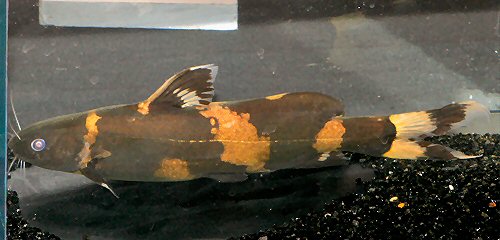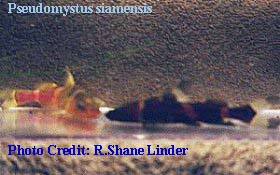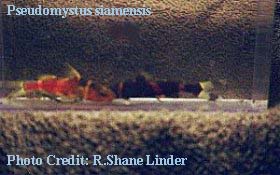SCOTCAT.COM
your internet guide to all things catfish
| Close, But No siamensis! |
by R. Shane Linder |
|
I have maintained bagrids from the genera: Mystus, Hemibagrus, Pelteobagrus, Pseudomystus, Bagrichthys, Horabagrus, Batasio and Leiocassis. One of my favourites has always been the common Asian bumblebee catfish, Pseudomystus siamensis. I recently, after a lot of work, failed to spawn Pseudomystus siamensis.
Pseudomystus siamensis
There are no known captive spawnings of this fish. Here are my notes and hoping that my failure will bring someone else luck down the road. One adult male (purchased 11 Aug 95 at 2.5 inches) and one adult female (purchased 15 Sept 95 at 1.5 inches) were removed from a twenty gallon tank they share with three other P. siamensis (1 male and two females). The male was selected because he is the larger and better looking of the two and the female was selected because she appeared the most gravid. Each fish was given its own ten gallon tank on 1 Dec 98 and fed heavily on frozen foods. Water changes of 50% were performed every week. On 30 Dec 98 both fish were moved to a ten gallon tank that was divided. One adult was placed in each half. The tank's parameters were pH 7.6, 150ppm DH, and Temp 78F. The tank was half full of water. Peat filtration and distilled water were used to lower the water's pH and hardness. 2 Jan 99, pH 7.2, 120 ppm DH, and Temp 81F (water tinted amber) 3 Jan 99, pH 7.2, 100ppm DH, and Temp 81F (removed all filtration to simulate dry season) 4 Jan 99, pH 7.0, 90ppm DH, Temp 83F 5 Jan 99, pH6.8, 90ppm DH, Temp 83F 6 Jan 99, pH6.8, 80ppm DH, Temp 83F 7 Jan 99, pH 6.8, 80ppm DH, Temp 83F 8
Jan 99, at 4:10pm added aeration (airstone,
biowheel 170, and 40 gallon capacity sponge filter
all at once) also added two gallons chilled distilled
water (pH 6, no hardness). Things to do different in
the future: Below are the photo's supplied by the author. You will notice the difference in colouration between the male (right) and female (left). Shane states that he finds this form of dichromatism (two colours) in all Pseudomystus species. (Editor)
Photo Credits: |
If you would like to contribute an article, please e-mail me. You will of course be credited for your work.
If you would like to donate any denomination of money to the site just click the above link button. All proceeds will go to running the site and hopefully to keep it going for a few years yet.
Print or e-mail this factsheet below





